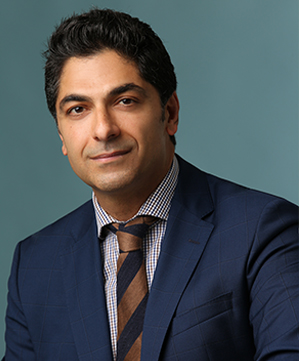Gluteus Medius Tear
A gluteus medius tear is a condition characterized by severe strain on the gluteus medius muscle that results in partial or complete rupture of the muscle.
The gluteus medius is one of the major muscles of the hip and is essential for movement of the lower body and keeping the pelvis level during ambulation. The gluteus medius muscle arises from the top of the pelvic bone and attaches to the outer side of the thigh bone or femur at the greater trochanter by the gluteus medius tendon. The muscle functions as a hip abductor, controlling side to side movement of the hip and providing stabilization to the joint. Gluteus medius tears often occur at the tendinous attachment to the greater trochanter of the femur bone.
Causes
The tear or rupture of the gluteus medius muscle is commonly seen in runners and athletes involved in high-impact sports such as soccer or basketball. It can occur from sudden bursts of activity and poor flexibility of the gluteus muscle. Any traumatic or overuse injury, or degenerative changes can also lead to partial or complete tear of the gluteus muscle.
Symptoms
The symptoms of a gluteus medius tear involve pain and tenderness over the lateral aspect of the hip which may be aggravated with activities such as running, climbing stairs, prolonged sitting or walking, and lying on the affected side of the hip. One of the main symptoms of a gluteus medius tear is the presence of Trendelenburg sign, evidenced by dropping of the pelvis towards the unaffected side during ambulation from being unable to properly bear weight on the affected limb.
Diagnosis
The diagnosis of a torn gluteus medius muscle starts with a physical examination of the patient including palpation of the affected muscle, testing muscle strength and assessing the walking pattern or gait of the patient. Special tests such as single-leg squat test or positive Trendelenburg sign confirms the diagnosis of a gluteus medius tear. MRI or ultrasound may be helpful to view the pathological changes of the muscle.
Treatment
The aim of treatment is to restore the normal function of the gluteus medius muscle. Immediately following the rupture, RICE therapy is initiated and involves:
- Rest
- Ice
- Compression
- Elevation
Medications such as nonsteroidal anti-inflammatory drugs or NSAIDs and steroid injections may be given to reduce the pain and inflammation. You should use a pillow between your legs when sleeping and avoid positions that overstretch the muscle. Assistive devices such as a cane or crutches may be used temporarily to facilitate pain free ambulation.
Surgical treatment may be recommended to repair a complete, full-thickness gluteus medius tear. The surgery can be performed endoscopically through tiny incisions to reattach the torn tendon back onto the greater trochanter with stitches. This helps to restore strength and function to the gluteus medius muscle.
Hip Labral Tear
A hip labral tear is an injury to the labrum, the cartilage that surrounds the outside rim of your hip joint socket. The hip joint is a ball and socket joint in which the head of the femur is the ball and the pelvic acetabulum forms the socket. The labrum helps to deepen the socket and provide stability to the joint. It also acts as a cushion and enables smooth movements of the joint.
Causes
A tear in the labrum of the hip can result from traumatic injury, such as a motor vehicle accident or from participating in sports such as football, soccer, basketball, and snow skiing. These sports are associated with sudden changes of direction and twisting movements that can cause pain in the hip. Repetitive movements and weight bearing activities over time can lead to joint wear and tear that can ultimately result in a hip labral tear. Degenerative changes to the hip joint in older patients can also lead to a labral tear.
Symptoms
Many patients with a hip labral tear do not have symptoms. However, some patients may experience pain in the hip or groin area, a catching or locking sensation in the hip joint, or significant restriction in hip movement.
Diagnosis
We will order certain tests to determine the cause of your hip pain.
X-rays of the hip allow your physician to rule out other possible conditions such as fractures or structural abnormalities.
Magnetic resonance imaging (MRI) may also be used to evaluate the labrum. An injection of contrast material into the hip joint space at the time of the MRI can help show the labral tears much clearer.
njection of local anaesthetic into the joint space is sometimes performed to confirm the location of the pain. If the injection completely relieves your pain, it is likely that the cause of the problem is located inside the hip joint.
Treatment Options
Treatment for a hip labral tear will vary depending on the severity of the condition. People with a minor labral tear recover within a few weeks with the help of non-surgical treatments.
Conservative treatments include:
- Medications: Anti-inflammatory medications can be helpful in relieving pain and reducing inflammation associated with labral tears. We may also recommend cortisone injections to alleviate the pain associated with a hip labral tear.
- Physical therapy: Physical therapy that helps to improve hip range of motion, strength, and stability are also recommended.
However, severe cases may require arthroscopic surgery to remove or repair the torn portion of the labrum.
Surgery
Hip arthroscopy, also referred to as keyhole surgery or minimally invasive surgery, is a surgical procedure in which an arthroscope, a narrow tube with a tiny camera on the end, is used to assess and repair damage to the hip.
The surgery is performed with the patient under general, spinal or local anaesthesia.
Your surgeon will make 2 or3 small incisions around the hip joint area. The arthroscope is inserted into the hip joint through one of the incisions to view the labral tear. The camera attached to the arthroscope displays the image of the joint on the monitor. A sterile solution will be pumped into the joint in order to have a clear view and room to work. Through the other incisions specially designed instruments are inserted. Your surgeon repairs the torn tissue by sewing it back together or removes the torn piece all together, depending upon the cause and extent of the tear. After the completion of the procedure, the arthroscope and instruments are removed and the incisions are closed.
Post- Operative Care
Following the surgery, you will be given instructions on caring for your incisions, activities to avoid and exercises to perform for a fast recovery and a successful outcome. Physical therapy will be recommended by us to restore your strength and mobility. We will also prescribe pain medications to keep you comfortable.




